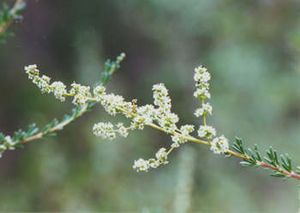Chamise facts for kids
Quick facts for kids Chamise |
|
|---|---|
 |
|
| Scientific classification | |
| Genus: |
Adenostoma
|
| Species: |
fasciculatum
|
Adenostoma fasciculatum, often called chamise (say: cha-MEES), is a tough shrub. You might also hear it called greasewood. This plant grows naturally in Oregon, Nevada, California, and northern Baja California. It's one of the most common plants in the California chaparral areas.
Contents
What Chamise Looks Like
Chamise is an evergreen shrub. This means it keeps its leaves all year round. It can grow up to 4 meters (about 13 feet) tall. Its branches look a bit dry and stick-like.
The leaves are small, only about 4–10 millimeters long. They are also very narrow, about 1 millimeter wide, and have a pointy tip. These leaves grow in small bunches on the branches. These bunches are called fascicles, which is where the plant gets part of its Latin name, fasciculatum.
The leaves are shiny because they have flammable oils, especially when the weather is warm. At the ends of the branches, you'll find bunches of small, white, tube-shaped flowers. Each flower is about five millimeters wide and has five petals with long stamens (the parts that hold pollen). The fruit of the chamise is a dry, small seed called an achene.
Because of its oily leaves, chamise is sometimes called greasewood. People sometimes mix up chamise with another plant called buckbrush (Ceanothus cuneatus). Both plants have lots of white flowers and grow in chaparral areas.
Where Chamise Grows
Chamise is very good at handling dry weather. It can also grow in soil that doesn't have many nutrients. You can find it on dry, rocky places. It even grows in special soils called serpentine soils, where most plants can't survive. It also grows well in slate, sand, clay, and gravel soils.
Chaparral habitats often have big wildfires. Chamise is well-suited for these fires. It dries out, burns easily, and then quickly grows back. This helps the plant thrive again. It's also great at stopping erosion. After a fire, new shoots grow from its base, which helps keep the soil from washing away.
Chamise often grows in thick, dense groups. These areas are sometimes called chamissal or Adenostoma fasciculatum chaparral. In these thickets, you might also find another plant called toyon growing alongside chamise.
How People Use Chamise
Chamise has been used for a long time as a medicinal plant. For example, some people use it to help with skin problems like eczema.
One way to make a balm is by soaking chamise branches and leaves in olive oil for about a month. Then, melted beeswax is mixed into the oily liquid. This mixture is poured into small containers and allowed to harden into a balm. This balm can be rubbed on rashes or skin lesions.
The Tongva people, who call the plant huutah, consider it a very useful medicine. They use the oils from the twigs and leaves. They also make a strong tea from the bark to treat skin infections. For sores and snakebites, they grind the leaves and twigs into a powder and mix it with animal grease, then apply it to the affected area.
Boiling the branches and leaves creates a liquid that can be used to bathe parts of the body that are sore, swollen, or infected. Huutah is also made into a tea to help with cramps, ulcers, and chest problems.
Many other Native American groups also use chamise. These include the Cahuilla, Coahuilla, Ohlone, and the Kumeyaay people.
Images for kids
-
Chamise resprouting after a high-intensity wildfire in San Diego County
-
Flowering in Poway, California.
See also
 In Spanish: Adenostoma fasciculatum para niños
In Spanish: Adenostoma fasciculatum para niños







